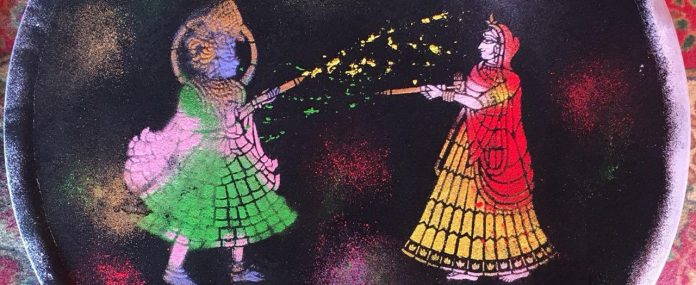According to ancient legends, when the young Lord Krishna would take his cows out for grazing, His consort Radha and her friends – the gopikas would spend the day decorating the floor and walls of their meeting place with beautiful patterns made of coloured powder, flowers, beads and stones.

Since Krishna would be out most of the day, their meeting time would be in the evening or ‘sanjh’. Hence the name of the art form- sanjhi. It also stems from the word ‘sajawat’ or decoration. And the reason that a Sanjhi Mahotsav is organized in the shraaddha period is mostly practical. As Vaishnavacharya Sumit Goswami, a priest of Vrindavan’s Radha Raman Temple says, “The timing for the Sanjhi Festival was decided upon by our venerated ancestors just so that children of the temple do not get bogged down by the solemn mood of this period. To keep them interested and involved in the temple activities, sanjhi art started being made.”
Just as Radha made sanjhi during the day and kept it ready in the evening for Krishna, so do the priests in the hope that Lord Krishna will visit the temple and bless them all.
Designs that delight

This art form is usually made with the help of stencils on an ‘ashtkon’– an octagonal-shaped platform called Radha Yantra. Its central panel invariably has a drawing of Radha and Krishna in one of their popular poses. The surrounding patterns depict subsidiary scenes from their lives and around them are decorations of latticed designs and floral compositions. Work on the sanjhi often starts in the morning and takes more than 10 to 12 hours to be completed since great attention is paid to details and the intricate patterns.
Post the evening prayers the crowds are allowed a darshan (dekko) of the sanjhi before the artwork is cleared away. The floor space is readied for a brand new sanjhi to be made in its place the next morning.
Change, the only constant

Over the years, with new ideas, sanjhi too has evolved and changed. Besides the floor, it is now also being made on the surface of water and on canvases with oil and water colours. Priests are taking sanjhi outside the temple precincts too through workshops and presentations to let more and more people become aware of this art form.
This year, the Sanjhi Mahotsav is being organised from September 25th to 28th.




